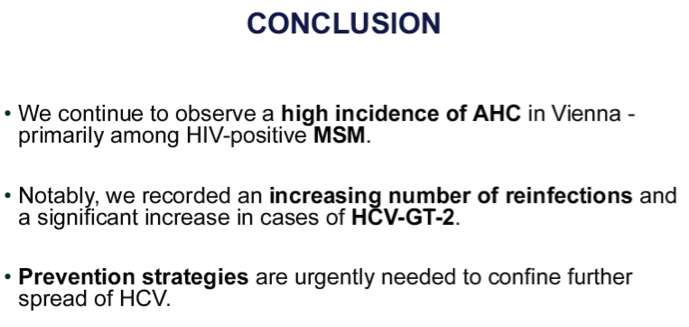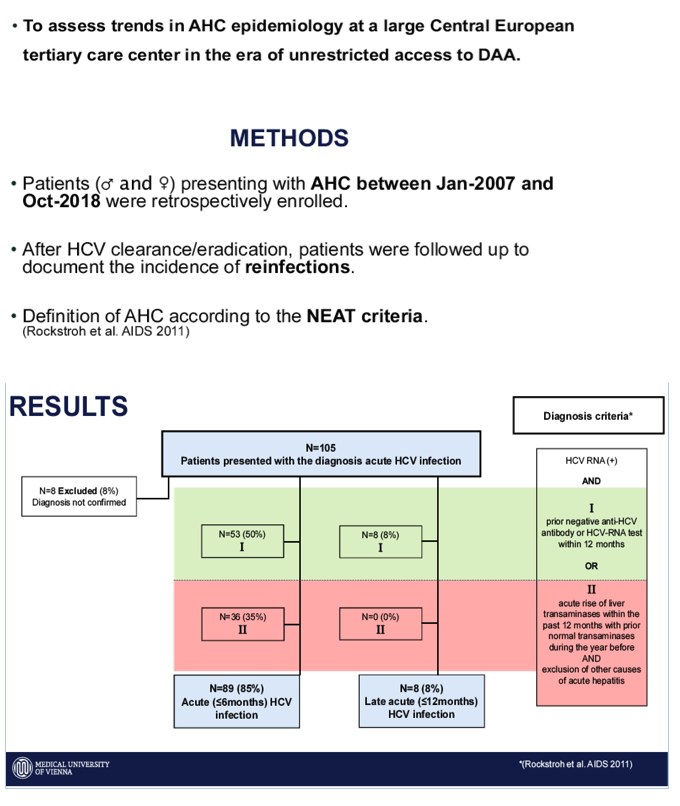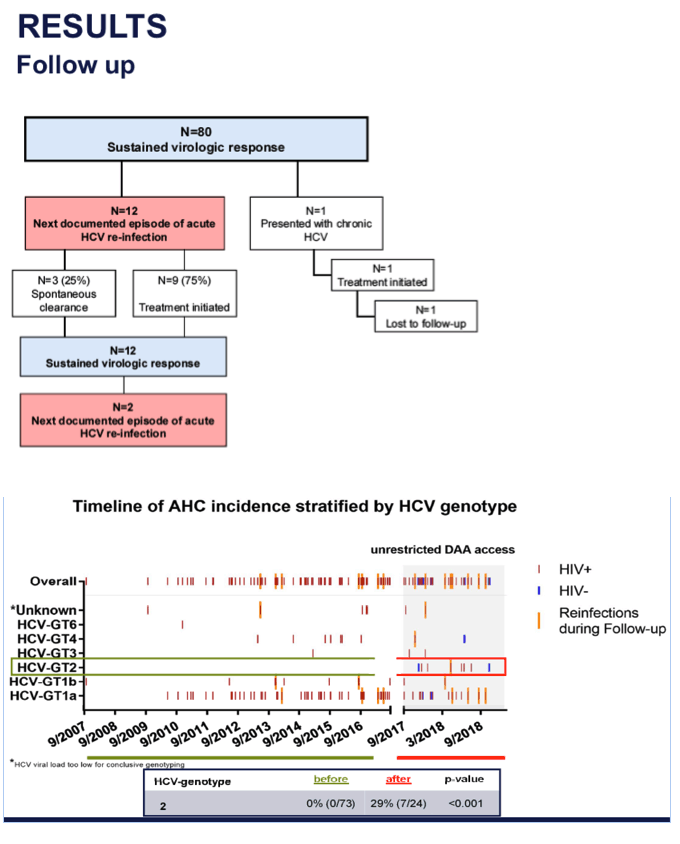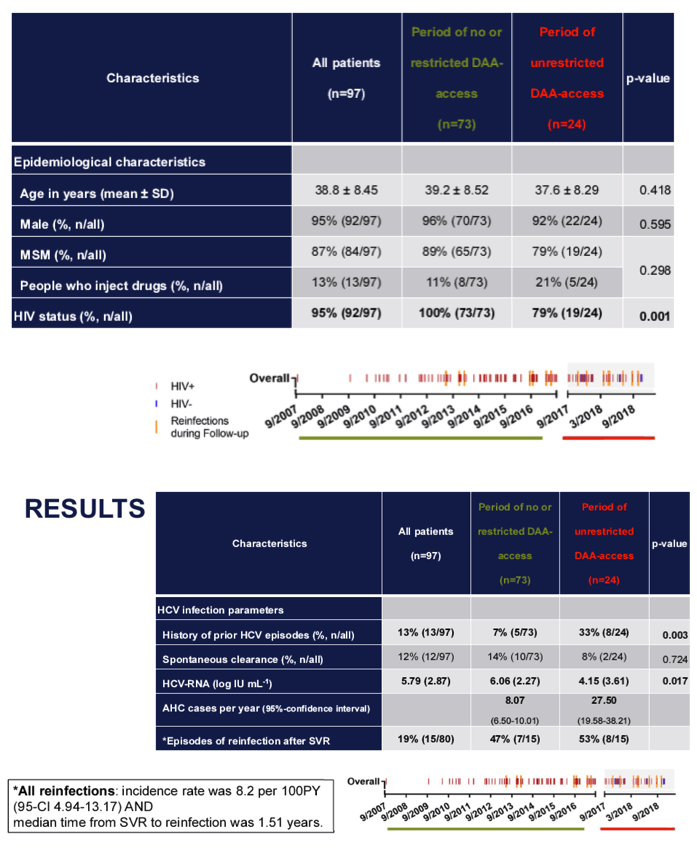 |
 |
 |
| |
Increasing incidence of HCV-GT2 and reinfections within the ongoing epidemic of acute HCV infections among MSM in Central Europe
|
| |
| |
Reported by Jules Levin
EASL 2019 April 10-14 Vienna
David CHROMY, David JM BAUER, Caroline SCHMIDBAUER, Philipp SCHWABL, Theresa BUCSICS, Bernhard SCHEINER, Gerold LANG, Michael GSCHWANTLER, Peter FERENCI, Michael TRAUNER, Mattias MANDORFER, Thomas REIBERGER

Program abstract
Increasing incidence of HCV-GT2 as well as reinfections within the ongoing epidemic of acute
HCV infections among MSM in Central Europe
David Chromy1 2, David JM Bauer1 2, Caroline Schmidbauer1 2 3, Philipp Schwabl1 2, Theresa Bucsics1 2,
Bernhard Scheiner1 2, Gerold Felician Lang4, Michael Gschwantler3, Peter Ferenci1, Michael Trauner1,
Mattias Mandorfer1 2, Thomas Reiberger1 2
1Medical University of Vienna, Department of Internal Medicine III, Division of Gastroenterology and
Hepatology, Vienna, Austria; 2Medical University of Vienna, Vienna HIV and Liver Study Group,
Vienna, Austria; 3Wilhelminenspital, Wiener Krankenanstaltenverbund (KAV) der Stadt Wien,
Department of Internal Medicine IV, Vienna, Austria; 4Medical University of Vienna, Department of
Dermatology, Division of Immunology, Allergy and Infectious Diseases, Vienna, Austria
Email: david.chromy"at"meduniwien.ac.at
Background and aims: An epidemic of acute hepatitis C virus (HCV) infections (AHC) among men who have sex with men (MSM) is currently observed in high-income countries. While a recent study reported a declining incidence of AHC, potentially due to the broad access to highly effective direct acting antivirals (DAA), other studies found a further increase in AHC among MSM. As a consequence of these conflicting reports, we aimed to assess the characteristics of AHC patients at a large Central European tertiary care center in the era of unrestricted DAA-access.
Method: Patients presenting with AHC between 01/07 and 10/18 were retrospectively enrolled and followed after virologic clearance/eradication. AHC was defined by the European AIDS treatment network (NEAT) criteria.
Results: We identified 97 AHC patients with a mean age of 39 ± 8 years at inclusion. The majority of patients were male (95%, 92/97), HIV-positive (95%, 92/97), and MSM (87%, 84/97). After introduction of nationwide unrestricted DAA-access in Austria in 09/17 (DAA-era), a history of prior HCV infection at inclusion (i.e. previous episode of AHC or chronic HCV infection) was more frequent (33%, 8/24 vs. 7%, 5/73; p = 0.003). Importantly, when comparing infections occurring in the 'pre-DAA-era' with infections after 09/17, we observed an increase in AHC incidence from 8.07 (95%-confidence interval
(95-CI) 6.50-10.01) to 27.50 (95-CI 19.58-38.21) cases per year.
Patients were followed after spontaneous clearance or sustained virologic treatment response (SVR) for a total of 183.11 patient-years (PY; median 1.04). During follow-up, 15 reinfections were observed in 13 patients, corresponding to an incidence rate of 81.9 per 1000PY (95-CI 49.4-131.7) and a median time from SVR to reinfection of 1.51 years. Moreover, more than half of all reinfections (53% 8/15 vs. 47% 7/15) occurred in the DAA-era.
Interestingly, while HCV-genotype (GT)1a remained the most common HCV-GT (53%, 17/32 vs. 70%, 56/80), an outbreak of HCV-GT2 AHC was observed (25%, 8/32 vs. 0%, 0/80) in the DAA-era among both HIV+ and HIV- individuals (Figure).
Conclusion: We continue to observe a high incidence of AHC in Central Europe-primarily among HIV-positive MSM, but increasingly also in HIV-negative MSM. Notably, we also recorded an increasing number of reinfections and a significant rise in GT-2. Prevention strategies are urgently needed to confine further spread of HCV.






|
| |
|
 |
 |
|
|